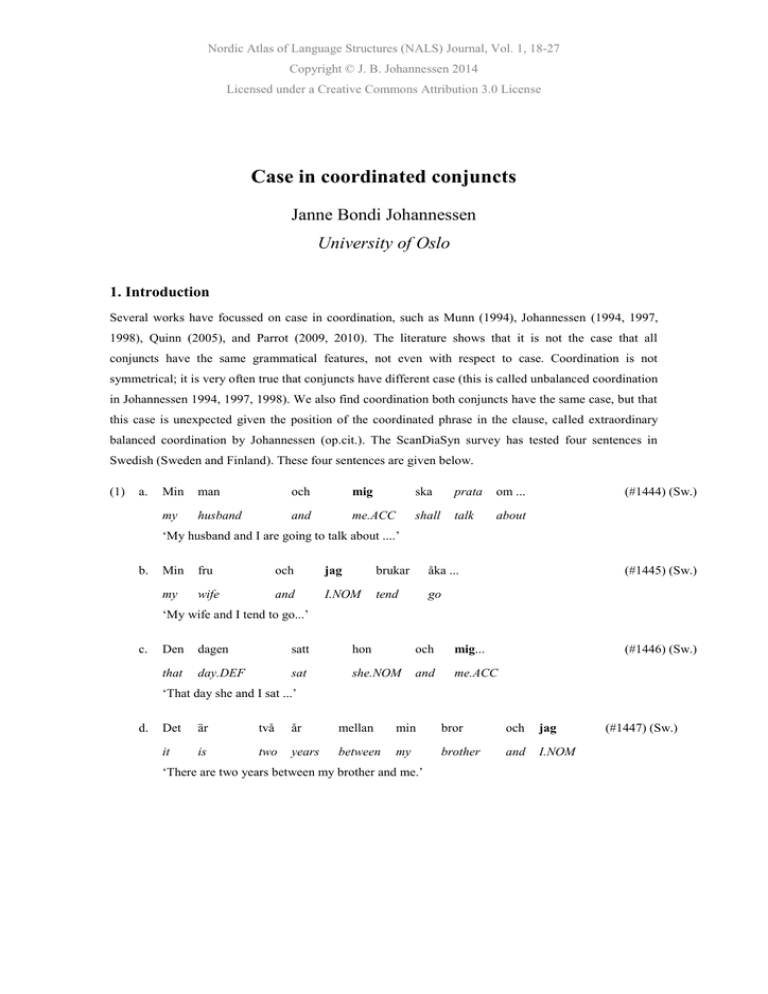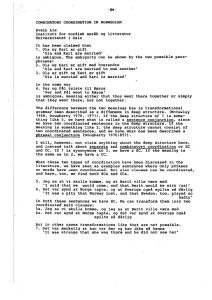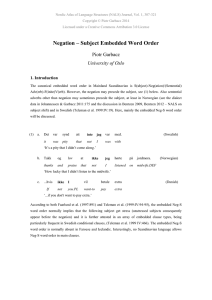Case in coordinated conjuncts
advertisement

Nordic Atlas of Language Structures (NALS) Journal, Vol. 1, 18-27
Copyright © J. B. Johannessen 2014
Licensed under a Creative Commons Attribution 3.0 License
Case in coordinated conjuncts
Janne Bondi Johannessen
University of Oslo
1. Introduction
Several works have focussed on case in coordination, such as Munn (1994), Johannessen (1994, 1997,
1998), Quinn (2005), and Parrot (2009, 2010). The literature shows that it is not the case that all
conjuncts have the same grammatical features, not even with respect to case. Coordination is not
symmetrical; it is very often true that conjuncts have different case (this is called unbalanced coordination
in Johannessen 1994, 1997, 1998). We also find coordination both conjuncts have the same case, but that
this case is unexpected given the position of the coordinated phrase in the clause, called extraordinary
balanced coordination by Johannessen (op.cit.). The ScanDiaSyn survey has tested four sentences in
Swedish (Sweden and Finland). These four sentences are given below.
(1)
a.
Min
man
och
mig
ska
prata
om ...
my
husband
and
me.ACC
shall
talk
about
(#1444) (Sw.)
‘My husband and I are going to talk about ....’
b.
Min
fru
och
jag
brukar
åka ...
my
wife
and
I.NOM
tend
go
(#1445) (Sw.)
‘My wife and I tend to go...’
c.
Den
dagen
satt
hon
och
mig...
that
day.DEF
sat
she.NOM
and
me.ACC
(#1446) (Sw.)
‘That day she and I sat ...’
d.
Det
är
två
år
mellan
min
bror
och
jag
it
is
two
years
between
my
brother
and
I.NOM
‘There are two years between my brother and me.’
(#1447) (Sw.)
Johannessen
Coordinated conjuncts
NALS Journal
2. Results
2.1 Nordic Syntax Database (NSD)
Below we present the four maps that represent the judgments for sentences (1a–d).
Map 1: Case in coordinated subject pronouns, accusative in second conjunct.
(#1444: Min man och mig ska prata om...’My husband and I are going to talk about…’)
(Black=low score)
Map 1 shows that no informants accepts a coordinated subject where the second conjunct has accusative
case.
19
Johannessen
Coordinated conjuncts
NALS Journal
Map 2: Case in coordinated subject pronouns, nominative in second conjunct.
(#1445: Min fru och jag brukar åka.. ‘My wife and I tend to go...’)
(White=high score)
Map 2 shows that all informants accept a coordinated subject in which the second conjunct has
nominative case.
20
Johannessen
Coordinated conjuncts
NALS Journal
Map 3: Accusative case in coordinated subject pronoun, second conjunct, in non-sentence-initial subject
(#1446: Den dagen satt hon och mig... ‘That day, she and I sat…’).
(Black=low score)
Map 3 shows that no informant accepts accusative case in the second conjunct of a coordinated subject of
a subordinate clause.
21
Johannessen
Coordinated conjuncts
NALS Journal
Map 4: Nominative case in the second conjunct of prepositional complement
(#1447: Det är två år mellan min bror och jag. ‘There are two years between my brother and I’).
(White = high score, black = low score)
Map 4 shows that there is variation in the extent to which Swedish informants accept nominative case in
the second conjunct of a coordinated prepositional complement.
2.2 Nordic Dialect Corpus (NDC)
Given that none of the other Nordic languages, apart from Swedish, has been tested for these questions on
coordination, we need to find data for the other Nordic languages. Here we will look at the transcriptions
and recordings of spontaneous speech, as it appears in Nordic Dialect Corpus (Johannessen et al. 2009).
Starting with Norwegian, a simple string search for the conjunction og 'and' followed by meg
'me', gives several interesting results. This search would give 9 results equivalent to sentences #1444 and
#1446 (i.e., subjects and subject predicates) if indeed they can be found. There are not many hits, but
22
Johannessen
Coordinated conjuncts
NALS Journal
some are presented in (2). They show that Norwegian has subject pronouns that do not have nominative
case. The results are all from Southern Norway, but here they span across the whole width, from
Hordaland and Rogaland via Vest-Agder to Akershus and Hedmark. The fact that there are no examples
from Trøndelag or Northern Norway may indicate a north-south divide, but there are too few data to be
sure.
a.
da
søkte
både
(Norwegian)
(2)
then
applied
both
han
og
meg...
he.NOM
and
me.ACC
‘Then both he and I applied...’ (evje_04gk)
b.
vi
delte
søstra
mi
og
meg...
(Nor.)
we
shared
sister.DEF
mine
and
me.ACC
‘we shared, my sister and I...’ (kirkenaer_04gk)
c.
og
Kåre
og
meg
gikk
i...
and
Kåre
and
me.ACC
went
in
(Nor.)
‘and Kåre and I went in...’ (kristiansand_02uk)
d.
kino
var
vi
nettopp
på
nå
Vilde
og
meg
cinema
were
we
just
at
now
Vilde
and
me.ACC
(Nor.)
‘We were just at the cinema, Vilde and I...’ (kvinnherad_03gm)
e.
vi
var
nede
der
en
gang
i
sommer
Vilde
og
meg
we
were
down
there
one
time
in
summer
Vilde
and
me.ACC
(Nor.)
‘We were down there once last summer, Vilde and I...’ (kvinnherad_03gm)
f.
nei
bare
bare
du
og
meg
(Nor.)
no
just
just
you.NOM
and
me.ACC
‘No, just you and me...’ (lommedalen_02uk)
g.
så
mor
og
meg
vaska
opp
so
mother
and
me.ACC
washed
up
‘so my mother and I washed up...’ (stavanger_04gk)
23
(Nor.)
Johannessen
Coordinated conjuncts
NALS Journal
The same search with respect to Danish gives 18 relevant hits (subjects and subject predicates). Since the
Danish part of the corpus is only a tenth of the size of the Norwegian part (211 000 words and 2 190 000
words, respectively), it is obvious that the 18 hits in the Danish part as against the 9 hits in Norwegian,
suggest that this phenomenon is much more common in Danish. The hits are from all across Denmark,
and there seems to be no dialectal variation here.
(3)
a.
altså
mor
og
mig
vi
hang
inni
den
radio
well
mother
and
me.ACC
we.NOM
hang
inside
that
radio
(Da.)
‘Well, my mother and I, we were hanging inside that radio...' (aeroe1)
b.
så
tager
vi
en
veninde
og
mig
så
tager
vi
af
sted
(Da.)
then
take
we
a
friend
and
me.ACC
then
take
we
off
place
‘then we, a friend and I, go off...’ (bornholm3)
c.
da
kørte
min
far
og
mor
og
min
søster
og
mig
then
drove
my
father
and
mother
and
my
sister
and
me.ACC
(Da.)
‘then my father, mother, my sister and I drove...’ (falster5)
d.
men
der
var
jo
tjenestepigen
og
mig
(Da.)
but
there
were
well
servant.girl.DEF
and
me.ACC
‘but there was of course the servant girl and I...’ (fyn6)
e.
øh
Martin
og
mig
vi
er
vendelboer
well
Martin
and
me.ACC
we.NOM
are
Vendelans
(Da.)
‘Well, Martin and I we are from Vendel...’ (nordjylland4)
f.
og
Anne
og
Martin
og
mig
vi
har
jo
kendt
hinanden
i
and
Anne
and
Martin
and
me.ACC
we.NOM
have
well
known
each
in
‘and Anne and Martin and me, we have known each other for...’ (nordjylland4)
24
other
(Da.)
Johannessen
Coordinated conjuncts
NALS Journal
The Danish results are corroborated by Parrot (2010); he found nearly 18 % pronoun mismatches
amongst coordinated NPs. There are, in comparison, no hits for a possible Swedish sequence och mig
('and me') in the NDC. Clearly the maps in section 2.1 is a true reflection of Swedish as opposed to
Norwegian and Danish. The latter two can have non-nominative pronouns in subject position as long as
the pronoun is the second (or third or fourth etc.) conjunct in a conjunction phrase. To conclude, both
Norwegian and Danish have sentences like #1444 and #1446, but Swedish does not.
Looking for sentences like #1447 in the NDC is easy. The search string for Norwegian and Danish is
simply preposition + any word + og 'and' + jeg 'I', and for Swedish the equivalent with och jag 'and I',
which would have given examples of a nominative pronoun conjunct in a conjunction phrase following a
preposition. There were only irrelevant examples of VP or CP coordination.
Finally, for the sake of completeness, we have tested whether the pattern in #1445 is found in the corpus.
Not surprisingly there are many examples for Swedish, given map 2. An example is this:
(4)
a.
for
för
mor
mother
och
and
jag
vi
I.NOM
ansåg
we.NOM
at
föräldrar
thought
skulle
that
vara
parents
kvar
should
(Swe.)
be
behind
‘for mother and I, we thought that parents should stay...’ (boda_om1)
In Norwegian, there were also countless examples. However, Danish had only a handful of hits. I present
one example of each of these:
(4)
b.
men
han
Mads
og
jeg
vi
driver
og
går
forskjellige
plasser
but
he
Mads
and
I.NOM
we.NOM
drift
and
go
diferent
places
‘but Mads and I, we usually go to places...' (aal_03gm)
c.
så
har
min
kone
og
jeg
boet
i
samme
hus
i
Rønne
then
have
my
wife
and
I
lived
in
same
house
in
Rønne
(Dan.)
‘then my wife and I have lived in the same house in Rønne...’ (bornholm1)
It is clear that overall, Danish is a real mismatch language, while Swedish is not, and Norwegian is
somewhere in between. It is clear that Danish and Norwegian share the possibility of having an
accusative second conjunct pronoun in subject position. However, it is also clear that Danish has
relatively many more hits in the corpus. Likewise, although there Danish has a handful of examples of
nominative second conjuncts in subject position, these are very few. There are many more of these in
Norwegian. Swedish only has nominative and no accusative ones, and thereby confirms the Swedish
maps. However, no corpus example was found anywhere of a nominative pronoun conjunct in the
25
(Norw.)
Johannessen
Coordinated conjuncts
NALS Journal
complement of the preposition. Here the prediction of the map was not borne out. We have not
investigated Faroese, but Parrot (2010) shows that this kind of case mismatch is completely unacceptable
for his 40 informants.
3. Discussion
The NSD shows that in Swedish, case in conjunction phrases follows the same rules as case in simplex
phrases; nominative is the subject case, non-nominative (accusative) is the case for objects and
complements of prepositions. However, in Norwegian and Danish, the NDC shows many examples of
unexpected case; what is called unbalanced coordination in Johannessen (1994, 1996, 1998). Here the
second conjunct in a conjunction phrase in subject position has accusative case. In Danish there are
actually very few examples of the expected nominative case in this position, showing that the unbalanced
coordination may be more the rule than the exception in Danish. Icelandic does not show anything
unexpected in the corpus. The Faroese part of the corpus has not been investigated, but Parrot (2009)
shows that Faroese behaves like Swedish.
References
Johannessen, Janne Bondi. 1994. Coordination. A minimalist Approach. PhD thesis. University of Oslo.
Johannessen, Janne Bondi. 1996. Partial Agreement and Coordination. Linguistic Inquiry;Volum 29.(3) s.
661-676
Johannessen, Janne Bondi. 1998. Coordination. New York: Oxford University Press.
Johannessen, Janne Bondi, Joel Priestley, Kristin Hagen, Tor Anders Åfarli, and Øystein Alexander
Vangsnes. 2009. The Nordic Dialect Corpus - an Advanced Research Tool. In Jokinen, Kristiina
and Eckhard Bick (eds.): Proceedings of the 17th Nordic Conference of Computational Linguistics
NODALIDA 2009. NEALT Proceedings Series Volume 4.
Lindstad, Arne Martinus; Nøklestad, Anders; Johannessen, Janne Bondi; Vangsnes, Øystein Alexander.
2009. The Nordic Dialect Database: Mapping Microsyntactic Variation in the Scandinavian
Languages. In Jokinen, Kristiina and Eckhard Bick (eds.): Proceedings of the 17th Nordic
Conference of Computational Linguistics NODALIDA 2009. NEALT Proceedings Series;Volume 4.
Munn, Alan. 1994. Topics in the Syntax and Semantics of Coordinate Structures, University of Maryland:
Doctoral Dissertation.
Parrott, Jeffrey K. 2009. Danish vestigial case and the acquisition of Vocabulary in Distributed
Morphology. Biolinguistics 3: 270-304.
26
Johannessen
Coordinated conjuncts
NALS Journal
Parrott, Jeffrey K. 2010. Case variation in coordination across Scandinavian varieties. Presented at Extra
CLCG Colloquium.
Quinn, Heidi. 2005. The Distribution of Pronoun Case Forms in English. Amsterdam: John Benjamins.
Web sites:
Nordic Atlas of Language Structures (NALS) Online: http://www.tekstlab.uio.no/nals
Nordic Dialect Corpus: http://www.tekstlab.uio.no/nota/scandiasyn/index.html
Nordic Syntax Database: http://www.tekstlab.uio.no/nota/scandiasyn/index.html
27

